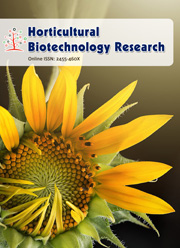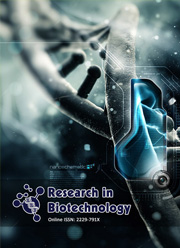Regional Polymorphism Assessment of Myanmar ‘Sein Ta Lone’ Mango (Mangifera indica Linn) from Sintgaing Township Based on Microsatellite Markers
DOI:
https://doi.org/10.25081/hbr.2019.v5.5447Keywords:
Polymorphism assessment, Sein Ta Lone, microsatellites (SSR) markers, Sintgaing TownshipAbstract
This study was conducted to explore the genetic diversity and relationship of Sein Ta Lone mango cultivars among 20 commercial orchards in Sintgaing Township, Mandalay region. Nine microsatellite (SSR) markers were used to detect genetic polymorphism in a range from (3 to 6) alleles with (4.33) alleles per marker in average. Six out of nine microsatellite markers gave the PIC values of greater than (0.5). Among them, SSR36 held the highest PIC values of (0.691) while MiSHRS39 and MN85 possessed the least PIC values of (0.368) and (0.387) respectively. The genetic diversity was expressed as unbiased expected heterozygosity (UHe) value with an average of (0.561). The genetic relationship was revealed by (UPGMA) dendrogram in a range of (0.69 to 1.00). Based on UPGMA cluster analysis, three main clusters were classified among three different locations. This study was intended to help cultivar characterization and conservation for proper germplasm management with the estimation of genetic variation and relationship in the existing population of Sein Ta Lone mangoes in Sintgaing Township by microsatellite markers.
Downloads
References
2. Begum H, Reddy MT, Malathi S, Reddy BP, Narshimulu G, Nagaraju J, Siddiq EA. Morphological and microsatellite analysis of intravarietal heterogeneity in ‘Beneshan’ mango (Mangifera indica L.). Int J Agric Food Res. 2014; 3: 16–33.
3. Dillon NL, Baly ISE, Wright CL, Hucks, L, Ines DJ, Dietzgen RG. Genetic diversity of the Australian national mango genebank, Scientia Horticulturae. 2013; 150: 213-226.
4. Eiadthong W, Yonemori K, Kansaki S, Sugiura A, Utsunomiya N, Subhadrabandhu S. Amplified fragments length polymorphism analysis for studying genetic relationships among Mangifera species in Thailand. Journal of the American Society for Horticultural Science. 2000; 125:160-164.
5. Gupta PK and Varshney RK. Cereal genomics: an overview. In Cereal genomics, edited by Gupta PK and Varshney, RK, 639. Dordrecht, The Netherlands: Kluwer Academic Press; 2004.
6. Hirano R, Htun Oo T, Watanabe K. Myanmar mango landraces reveal genetic uniqueness over common cultivars from Florida, India, and Southeast Asia. G enome.2010; 53:321-330.
7. Hirano R, Ishii H, Htun Oo T, Gilani S, Kikuchi A, Watanabe K. Propagation management methods have altered the genetic variability of two traditional mango varieties in Myanmar as revealed by SSR. Plant Genetic Resources. 2011; 9(3):404-410. doi:10.1017/ S14792 62111000049.
8. Karihaloo JL, Dwivedi YK, Archak S and Baldev Gaikwad A. Analysis of Indian mango cultivars using RAPD markers. The Journal of Horticultural Science and Biotechnology.2003; 78: 285-289.
9. Kashkush K, Jinggui F, Tomer E, Hillel J, Lavi U. Cultivar identification and genetic map of mango (Mangifera indica). Euphytica. 2001; 122: 129-136.
10. Kit YS and Chandran S. A simple, rapid and efficient method of isolating DNA from Chokanan mango (Mangifera indica L.) African Journal of Biotechnology. 2010; 9(36):5805-5808.
11. Kumar H, Narayanswamy P, Prasad T, Mukunda GK, Sondur S. Estimation of genetic diversity of commercial mango cultivars using RAPD markers. Journal of Horticultural Science and Biotechnology. 2001; 76: 529-533.
12. Kumar M, Ponnuswam V, Nagarajan P, Jeyakumar P and Senthil N. Molecular characterization of ten mango cultivars using simple sequences repeat (SSR) markers. African Journal of Biotechnology. 2013; 12(47):6568-6573.
13. Myat K. Export conditions of Myanmar mango: hindrances and opportunities in the supply chain. Master Thesis Dissertation, Faculty of Agriculture, University of Bologna, Italy; 2012.
14. Nei M, Roy Choudhury AK. Sampling variances of heterozygosity and genetic distance. Genetics. 1974; 76: 379-390.
15. Paing Htway HT, Yee Soe AN, Myint MM, Yi KP, Nyein Chan NN, et al. Genetic Diversity and Genetic Uniqueness of Indigenous Myanmar Mango (Sein Ta Lone) Cultivar in Kyaukse District. Int J Plant Biol Res. 2018; 6(3): 1089.
16. Pandey SN. Mango cultivars, in Srivastav, R.P.P. (Ed.) Mango Cultivation, International Book Distributing Company, Lucknow, India. 1998; 39-99
17. Pandit SS, Mitra S, Giri AP, Pujari KH, Patil BP, Jambhale ND and Gupta VS. Genetic diversity analysis of mango cultivars using inter simple sequence repeat markers, Current Science. 2007; 93:1135-1141.
18. Popenoe W. Manual of Tropical and Sub topical Fruits, MacMillan, New York, USA; 1920.
19. Ravishankar KV, Mani, BHR, Anand L and Dinesh MR. Development of new microsatellite markers from mango (Mangifera indica) and cross-species amplification. Americian Journal of Botany. 2011; 98:e96–e99.
20. Rohlf FJ. NTSYS-pc: Numerical taxonomy and multivariate analysis system, version 2.1 Exeter Software, Setauket, New York, USA; 2000.
21. Schnell RJ, Brown SJ, Olano CT, Meerow AW, Campbell RJ and Kuhn DN. Mango genetic diversity analysis and pedigree inferences for Florida cultivars using microsatellite markers. Journal of the American Society for Horticultural Science. 2006; 13: 214-224.
22. Singh AK, Devanshi Sharma P, Singh R, Singh B, Koundal KR, Singh NK. Assessment of Genetic Diversity in Ziziphus mauritiana using Inter-Simple Sequence Repeat Markers, Journal of Plant Biochemistry and Biotechnology. 2007;16:35-40.
23. Singh S, Bhat KV. Molecular Characterization and analysis of geographical differentiation of Indian Mango (Mangifera indica L) germplasm, Acta Horticulturae (ISHS). 2008; 839: 599-606.
24. Soe TT. Studies on Improved Methods of Postharvest Storage of Mango Fruits. PhD Thesis Dissertation Graduate School of Agriculture Tokyo University of Agriculture Japan; 2006.
25. Vaiman D, Mercier D, Moazami-Goudarzi K, Eggen A, Ciampolini R, Lépingle A, Velmala R, Kaukinen J, Varvio S, Martin P. A set of 99 cattle microsatellites: Characterization, synteny mapping, and polymorphism. Mamm. Genome. 1994; 5: 288–297.
26. Vavilov NI. Centres of origin of cultivated plants, bulletin of applied botany of genetics and plant-breeding. 1926; 16: 1-24.



 .
.